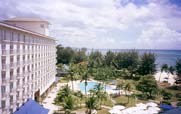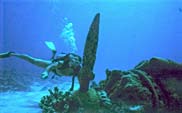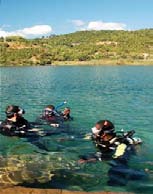Saipan, Statia, Lake Malawi, Key Largo...Contents of this Issue: Saipan, Statia, Lake Malawi, Key Largo... Gulf Coast Dive Shop Files Lawsuit Against BP At What Cost For a Third Dive? A Dive Camera that Floated 1,000 Miles and Still Works A New Twist on Divers and Drugs Editorial Office: Ben Davison Publisher and Editor Undercurrent 3020 Bridgeway, Suite 102 Sausalito, CA 94965 reports from the back of beyond from “undercover” readers from the July, 2010 issue of Undercurrent
A couple of years after our introductory issue in October 1975, a close friend offered to travel on his own dollar to Micronesia and provide reviews. While I knew he worked for the CIA, he was headed off on vacation and assured me he would remain anonymous and tell no one he was writing for Undercurrent. Months later, I learned he had printed up business cards and traveled as an Undercurrent writer, which became his cover. During the middle of his dive trip, he disappeared for a month, only to resurface in Saipan as an Undercurrent writer. While he did write honestly and frankly about the diving, he broke my rules for anonymity, never copped to it and never would tell me what secret mission he tackled during the month he evaporated. We have not written much about Saipan since, so I was pleased to get this report from long-time Undercurrent subscriber, James Hansen of Weeki Wachee, FL, who has assured me he is not a CIA operative, at least no longer.
Saipan’s WWII Wrecks and Reefs. “Occasionally travelers and divers need to rediscover a place that has been out of our sights for a long while, and Saipan is just such a place. Part of the Commonwealth of the Northern Mariana Islands, Saipan is 120 miles north of Guam, the hub for reaching Palau, Yap and Chuuk (Truk) Lagoon. Like Truk, it was the site of a tremendous World War II battle. Wrecks include a 407-foot-long freighter (alternately called the Chinsen or the Shoan Maru) and a smaller subchaser. Typical aircraft sites include the so-called B-29, actually a large Japanese flying boat, and the Zero wreck, more likely a small seaplane. All are on the west side of the island, near the capital of Garapan, and all are in 35 feet or less of water - - fine for snorkelers as well as divers. If you take the five-mile journey to Tinian, you’ll see the remains of land vehicles scattered at Dump Cove, some 60 feet deep at most. “Saipan also hosts dazzling marine life typical of the western Pacific. On the first half of the trip alone, I saw an extraordinary array: bannerfish, anemonefish, blue-streaked gobies, lionfish, scorpionfish, Picassofish, Moorish idols, various butterflyfish, a six-foot moray eel, a snowflake moray, whitetip reef sharks, arceye hawkfish perched on corals, angelfish, surgeonfish, yellow tangs, turtles, octopuses with spans up to three feet, Achilles tangs, garden eels, and crabs about half the size of my little fingernail. Two premier dive sites, Dimple and Ice Cream, are seamounts. The first is down to some 120 feet with a top 40 feet below the surface, while the latter is about 60 feet deep and has a top only 18 feet deep. Both have extensive marine life. Another popular site is Grotto (northeast Saipan), a huge cavern with three exit holes leading to the open sea. I hooked up with Global Ocean Divers, located at the Fiesta Resort and Spa in Garapan (http://godivers.net). General Manager Kazuhiro Nakamura and marketing manager Eva McKinney are both highly professional and helpful dive guides.They operate two small boats that cover all the dive sites in Saipan and in neighboring Tinian. “For WWII buffs, land tours include Suicide Cliff and Banzai Cliff, sites of mass suicides in the 1944 battle. Other attractions include the last Japanese command post, plus Japanese-built buildings such as the jail, hospital and lighthouse. Don’t miss picturesque Bird Island. There is a vibrant “entertainment” industry and lots of “poker rooms,” not to mention the cockfight arena with the handicapped parking sign! Restaurants feature Chinese, Japanese, Korean and Thai cuisine, although American food can be found. A taxi or rental car is necessary to visit the various beaches and towns scattered around the island, measuring about 13 by 7 miles. “It is a long plane ride via Continental, some 6,000 miles west of San Francisco and 3,200 miles beyond Honolulu. As a commonwealth of the U.S. and one that was liberated by U.S. troops, Saipan is a friendly destination for Americans. English and Japanese are the paramount languages, although Japanese tourists far outnumber U.S. tourists. The U.S. dollar is the local currency. For most people, a visit of a week to 10 days would be plenty. While the wrecks are less intact and spectacular than those in Truk Lagoon, and the marine life in Palau is more stunning and varied, it’s the perfect destination to get both wrecks and reefs. The water temperature during my June visit last year was a comfortable 84 degrees, with visibility of 80 to 120 feet on most dives.” Ocean Rover, Indonesia. For years, Undercurrent readers have had high regard for this liveaboard while she was plying the seas off Thailand and Burma. Now under new owners, she is diving Indonesia and still getting kudos. William and Carol Bynum (Midland, TX) were aboard in May and were half the passenger load on a craft that can hold 16. “Great trip around North Sulawesi. Crew attention and accommodations were superb. Upper deck cabins are doubles, which were plenty large for two of us. Lower deck has two doubles and two single share cabins. We loved the owner/manager, Roman, and his outstanding crew. This was an exploratory cruise to Talaud. Some dives were so-so but on an exploratory trip, you go with the information that’s available. Having a personal dive guide and only two divers per dinghy made for wonderful critter finding and photography. North Sulawesi does not have the soft corals of Raja Ampat. Many underwater volcanoes are interesting but have sparse growth. Found two interesting wrecks. Spent the last dive day in Lembeh Straits. Ocean Rover does Raja Ampat cruises, and we would book this boat again and again. Lots of space for photographers to set up and work on rigs, and lots of 110- and 220-volt outlets.” (www.ocean-rover.com) Captain Slate’s Atlantis Dive Center, Key Largo. One downside for experienced divers looking to get wet in the Florida Keys is the hordes of beginner divers. Most shops cater to them, so some dives are dumbed down; if you’re trying to get to exotic sites like the wrecks, you might be diverted if too many newbies show up. So we are pleased to note JoAn Ferguson’s (Herndon, VA) experience. “We planned to dive with Captain Slate’s for 10 dives, including the Spiegel Grove and the Duane. They had mostly beginner divers who didn’t want to ‘go deep’ and so they arranged for us to dive the wrecks with other shops. This allowed us to pay the ‘bundled’ price for the dives and got us where we wanted to go.” Keep Slate’s in mind if wrecks are your goal. (www.captainslate.com) Bonaire’s Annoyances. For Caribbean diving, Bonaire is hard to beat, especially with access to so many reefs from the beach. But we must call the government to task for its inability to handle petty crime. Its impact on divers is pointed out very succinctly by George Lock Jr. (West Grove, PA) who was there in March. “The petty crime frequently reported on Bonaire does affect the way one behaves. Everything must be locked up. Nothing can be left in unattended vehicles, so all of your dive and photo gear must be locked up. While that doesn’t sound so bad, it necessitates a lot more hauling around, from dive lockers and rooms to and from the boats. Contrast that with Little Cayman, where one can leave gear hanging in the open and cameras soaking in unattended rinse tanks right at the dock, with no fear of problems. Why the local community and businesses allow this problem to persist on Bonaire is a mystery, because it does affect the logistics and ease of diving.” St. Eustatius, Netherlands Antilles. I reviewed this little island for Undercurrent a few years back and not only was I pleased with the quality of its reefs but also the simple and uncomplicated ways that made the island a pleasant place to visit. So I feel compelled to provide an update, as seen through the eyes of Lynn M. Thorne (Raleigh, NC) who visited in March. “Virtually no commercialism or gimmicky trappings of so many vacation destinations. The Statian people are friendly and courteous. The island is also almost completely crime-free, so exploring anywhere feels safe. The small village located on a bluff 150 vertical feet above our hotel and dive operation has an endless amount of beautiful tropical vistas overlooking a blue Caribbean Sea. (Hint: Visit the numerous mom & pop bakeries.) Our 14 Gypsy Divers from Raleigh, NC, stayed at The Old Gin House. The rooms were clean and roomy, with large showers and enough hot water. The grounds are tropical with an old-world charm. Most of our group has been to dive operations all over the Caribbean, and we all felt the Golden Rock Dive Center ranks very high in attention to customer service, safety, flexibility and professionalism. Owners Glen and Michelle could not have been more attentive. The experienced divemasters, Matt and Stephen, both pointed out interesting items underwater without being overbearing. They have two boats; we used their large pontoon boat with six exits for an easy giant stride into the calm blue waters. The dive sites varied, with many cool wrecks to beautiful coral- encrusted lava formations. The diving is an easy, slow pace. Underwater life is abundant with all the usual Caribbean beauties, including curious turtles, rays and huge aggressive lobsters. Visibility topped 80 feet all week. To see my video of Statia, go to www.vimeo.com/10167831 and www.vimeo.com/10161258.”(www.goldenrockdive.com) Diving with Mouth Breeders in Lake Malawi, East Africa. What has always made Undercurrent unique is that by not carrying advertising, we can devote space to any diving destination in the world . We do not use that old dive publication rule: Run an ad if you want us to write about you (and if you do, we will surely speak kindly). We try to cover every place our readers visit so that information is in our online archives for others. The latest far-reaching place is Lake Malawi, located between Malawi, Mozambique and Tanzania. It’s a place you’d probably only go if you were on an African safari. Nonetheless, last year Londoner Jonny Newton, who now lives in Pretoria, South Africa dived Lake Malawi last year as a PADI instructor working at Aqua Africa (www.aquaafrica.co.uk). We asked him to fill in our readers on what to expect. “Malawi is a small, landlocked nation where you can drop your guard and not worry about being hassled by the multitude of hawkers who pop up at tourist destinations elsewhere. Malawi has more of a chilled-out Caribbean feel, which is only enhanced when you reach the shores of its eponymous Lake Malawi, the size of Wales. At an altitude of 540 feet, a diver must switch his computer to its correct altitude setting or add 10 percent to the depth, whilst working out nitrogen levels and ascending twice as slow as at sea level. Water varies from 75 degrees in June to 86 degrees in December. Along the northern lakeshore, visibility can peak at 65 feet in May. Dive schools stretched from Nkhata Bay in the north to Cape Maclear in the south, making accessibility and equipment rentals no problem. Most clients are backpackers attracted to the laid-back lifestyle of dusty Nkhata Bay. Accommodations suit all tastes and budgets.
“What makes Malawi diving beautiful isn’t just the stunning rock formations that are an underwater continuation of the escarpment, but also the more than 1,000 different types of fiercely territorial cyclids that vary remarkably between different locations; some of the fish you swim with cannot be found anywhere else in the world. Some aquarium enthusiasts pay hundreds of dollars for one rare specimen. Fish of deep blue and purple shimmer through the translucent waters, complemented by others of bright yellows and whites. They graze on rock algae, each species developing different lip formations so as not to compete over the same food source. Some have even evolved to spend their entire existence upside-down to monopolize the underside of subterranean slabs. I couldn’t go on a dive without seeing mouthbreeders. Females lay their eggs and then scoop them in their mouths for protection, where they are fertilized and hatched. On safe ground, mothers release their brood of up to100 and keep a watchful eye for predators while they feed and the young take their first tentative fin movements. If a mother feels threatened, she will swim up to the brood, open her mouth and in two or three sweeps, all the young form a tight clump and swim back in. Nearby, the male will be tidying his crater in order to attract another egg-laying female to it. “Dolphinfish have learnt to utilize the regular night divers’ flashlights to make their hunts more effective. Leaving the Aqua Africa jetty at sundown, we motored the five minutes to Playground Point. The shrills of cicadas on land were strangely complemented by the cacophony of dubious African pop filtering from various drinking dens in town. We followed the anchor line to a sandy patch surrounded by red rocks. As if on cue, a dozen dolphinfish were ducking and diving between us, revving themselves up at the promise of a good feed. The name ‘dolphinfish’ is a misnomer. I’d have named them ‘eel-like uglyfish.’ Reaching three feet in length, with small eyes and a snarly snout, they rely on electric sensors to track their prey - - unless, of course, there is a flashlight-wielding diver at hand. Following the dive group like a pack of hungry dogs for the entire 40 minutes, the predators would sidle up to any unfortunate cichlid mesmerized by the artificial light. Arching their spines in preparation for a quick lunge and snap, they audibly clamped their jaws on dinner. The elusive Kampango catfish with its shark-like dorsal fin often appears, as do freshwater crabs scavenging the bottom. Back at the sandy patch for our safety stop, we turn our flashlights off. Silent but for our breaths, we stare at the clean night sky from 16 feet below. “Diving in the northern part of the lake is sheltered by a natural harbor, so there is usually protection from the easterly August winds. Tropical rains start by mid-November and continue with a range of intensity till April, though never enough to stop a dive!” - - Ben Davison |

I want to get all the stories! Tell me how I can become an Undercurrent Online Member and get online access to all the articles of Undercurrent as well as thousands of first hand reports on dive operations world-wide
| Home | Online Members Area | My Account |
Login
|
Join
|
| Travel Index |
Dive Resort & Liveaboard Reviews
|
Featured Reports
|
Recent
Issues
|
Back Issues
|
|
Dive Gear
Index
|
Health/Safety Index
|
Environment & Misc.
Index
|
Seasonal Planner
|
Blogs
|
Free Articles
|
Book Picks
|
News
|
|
Special Offers
|
RSS
|
FAQ
|
About Us
|
Contact Us
|
Links
|
3020 Bridgeway, Ste 102, Sausalito, Ca 94965
All rights reserved.




